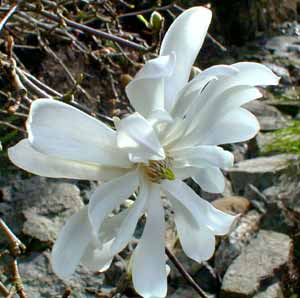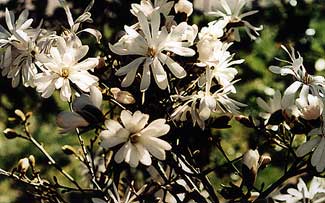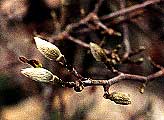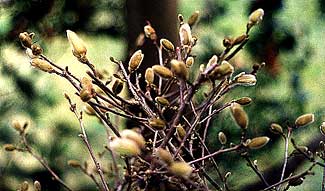 Royal Star Magnolia:
Royal Star Magnolia:
a year round delight
"She runs among whistling leaves; I hurry after;
She dances in dreams over white-waved water;
Her body is white & fragrant & cool,
Magnolia petals that float on a white-starred pool . . .
I have dreamed of her, dreaming for many nights."
-Conrad Aiken
(1889-1973)
(1889-1973)
Magnolia stellata 'Royal Star' is a popular magnolia cultivar producing scads of large mildly fragrant snowy-white double-flowers from mid-March through April before its leaves emerge. It prefers full sun but will tolerate a partially shady location.
Ours was for a couple of years growing in the shade of two large evergreens. I had underlimbed a big holly tree so that the magnolia got a bit of morning sun, but the predominance of shade did mean it was growing even more slowly than its typically slow rate.
At first, an overdose of shade did not put the kabosh on it producing extravagant numbers of ribbony flowers. For two years running, it was thick with blossoms. But it must have used up some stored energy for bud-manufacture, as in the third year the blooms were only half so many, & mostly on only one side of the shrub, the side with morning sun.
 So, much as I hated to do it, since it had gotten such a good root system by then, eventually I did a spring transplant. It was horror to move, the rootball was enormous, & wore me to a frazzle getting it to a lower garden where it would get full morning sun. The huge hole it left was filled in & replanted with ferns & jack-in-the-pulpits surrounding a young 'Bluebird' mountain hydrangea. The following spring (2004) the Star Magnolia bounced right back to its former floweriness, but in 2005 it flowered much less well. Magnolias are in general very unhappy to be torn out of the ground & moved, 'Royal Star' more forgiving than most magnolias, but even it can take two years to resettle.
So, much as I hated to do it, since it had gotten such a good root system by then, eventually I did a spring transplant. It was horror to move, the rootball was enormous, & wore me to a frazzle getting it to a lower garden where it would get full morning sun. The huge hole it left was filled in & replanted with ferns & jack-in-the-pulpits surrounding a young 'Bluebird' mountain hydrangea. The following spring (2004) the Star Magnolia bounced right back to its former floweriness, but in 2005 it flowered much less well. Magnolias are in general very unhappy to be torn out of the ground & moved, 'Royal Star' more forgiving than most magnolias, but even it can take two years to resettle.The species can potentially grow to twenty feet, though ten feet is most common for the cultivars, & it is generally as wide as it is tall. Ours was only five feet tall & four wide as of spring 2002, but when it was moved in 2003, it was pruned back to four feet & has put on very little growth since.
When we first obtained the Royal Star, it had been overly pruned to give it a compact appearance. It is usually recommended that it be cut back after flowering to maintain a formal appearance, but we wanted ours to take on more of an untamed look, so we were letting it go unpruned up to the time of the transplant. It had been growing more branches primarily on the side that got better sun, so when we moved it, we trimmed to an even shape. In the future any pruning will be to encourage mostly upright growth & not too great a width, but we're still waiting for it to completely overcome the formal appearance.
 Royal Star Magnolia has a distinct winter interest too. Not only are the naked branches quite attractive & the bark appealing, but in it's winter quiescence it produces pubescent buds at the tips of the branches that look remarkably like pussy willow pussies. The smaller bud photo is from early January; the larger bud photo is from late March.
Royal Star Magnolia has a distinct winter interest too. Not only are the naked branches quite attractive & the bark appealing, but in it's winter quiescence it produces pubescent buds at the tips of the branches that look remarkably like pussy willow pussies. The smaller bud photo is from early January; the larger bud photo is from late March.The shrub is not particularly cold hardy for maximum bud development. It does great in temperate regions like in Japan or here in the the Pacific Northwest, & it will survive in chillier regions too, but it may not flower so well if it gets cold enough to freeze off winter buds. So, too, hotter climates often ruin the flowers as fast as they emerge. In areas with springs that have summery temperatures, it should be very well protected from extremes.
 The caveats of possible freeze or heat damage to buds & blossoms aside, the shrub itself is adaptable & will be lush & green in many zones, & is not prone to any diseases. Still, for maximum flower power, it wants moderate seasons like ours (in Zone 8).
The caveats of possible freeze or heat damage to buds & blossoms aside, the shrub itself is adaptable & will be lush & green in many zones, & is not prone to any diseases. Still, for maximum flower power, it wants moderate seasons like ours (in Zone 8).M. stellata was introduced into American gardens in the 1860s when Japan was still unwilling to trade with the west, so it is one of the oldest Japanese shrubs of the scores that would soon follow. In its native Japan it is called Sidekobusi, "Seed of the Warrior Fist," after the shape of the interesting fruit it bares, making it perfect for a karateka's garden, or beside which to perform judo exercises & feel dangerously zen.
Unfortunately it doesn't seem to produce a lot of these fists-of-fury, unlike our Oyama Magnolia which is generous with its seed pods. The Royal Star's fruit dries out & in September slits appear in the sides of the fruit to disperse the orange seeds, which can be collected immediately before they let loose of the the pod & planted in greenhouse conditions.
It prefers rich acidic soil but is adaptable. Though it is at its most impressive blooming in late March or for the first half of April, ours also blooms in summer & early autumn, just a random bloom or two now & then when the foliage is most lush.
Newly emerging leaves are bronzy & quickly turn green, but autumn colors are not especially consequential, yellowish green is about the extent.